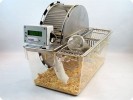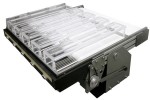Authors
A Dayal, K Schrötter, Y Pan, K Föhr, W Melzer, M Grabner
Lab
Medical University of Innsbruck, Austria
Journal
Nature Communications
Abstract
Skeletal muscle excitationcontraction (EC) coupling is initiated by sarcolemmal depolarization, which is translated into a conformational change of the dihydropyridine receptor (DHPR), which in turn activates sarcoplasmic reticulum (SR) Ca2+ release to trigger muscle contraction. During EC coupling, the mammalian DHPR embraces functional duality, as voltage sensor and l-type Ca2+ channel. Although its unique role as voltage sensor for conformational EC coupling is firmly established, the conventional function as Ca2+ channel is still enigmatic. Here we show that Ca2+ influx via DHPR is not necessary for muscle performance by generating a knock-in mouse where DHPR-mediated Ca2+ influx is eliminated. Homozygous knock-in mice display SR Ca2+ release, locomotor activity, motor coordination, muscle strength and susceptibility to fatigue comparable to wild-type controls, without any compensatory regulation of multiple key proteins of the EC coupling machinery and Ca2+ homeostasis. These findings support the hypothesis that the DHPR-mediated Ca2+ influx in mammalian skeletal muscle is an evolutionary remnant.
BIOSEB Instruments Used:
Spontaneous activity wheels (BIO-ACTIVW-M),Grip strength test (BIO-GS3),Treadmill (BX-TM),Passive avoidance (LE870)

 Pain - Thermal Allodynia / Hyperalgesia
Pain - Thermal Allodynia / Hyperalgesia Pain - Spontaneous Pain - Postural Deficit
Pain - Spontaneous Pain - Postural Deficit Pain - Mechanical Allodynia / Hyperalgesia
Pain - Mechanical Allodynia / Hyperalgesia Learning/Memory - Attention - Addiction
Learning/Memory - Attention - Addiction Physiology & Respiratory Research
Physiology & Respiratory Research
 Pain
Pain Metabolism
Metabolism Motor control
Motor control Neurodegeneration
Neurodegeneration Cross-disciplinary subjects
Cross-disciplinary subjects Muscular system
Muscular system General activity
General activity Mood Disorders
Mood Disorders Other disorders
Other disorders Joints
Joints Central Nervous System (CNS)
Central Nervous System (CNS) Sensory system
Sensory system Bioseb on booth #14 at OARSI 2024 in Vienna
Bioseb on booth #14 at OARSI 2024 in Vienna 


